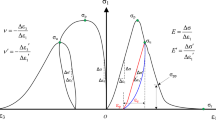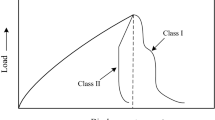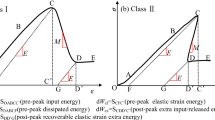Abstract
To systematically study the influence of loading environment system stiffness (LESS) on post-peak stress–strain curves and failure modes of brittle hard rocks, marble and granite specimens are tested under uniaxial compression under axial-strain-controlled loading using a brittle hard rock testing system named Stiffman with variable LESS. The test results show that the post-peak descending slopes of the stress–strain curves under low LESS are steep, and with the increase of the LESS, the slopes are gentle. In addition, as LESS increases, AE events in the post-peak deformation stage gradually transit from a concentrated distribution near the peak strength to a dispersed distribution in the whole post-peak deformation stage, and the maximum AE rate and the maximum cumulative AE count decrease approximately linearly with the increase of LESS. The number of splitting macrocracks and the degree of damage decrease as LESS increases, indicating that the post-peak failure process is more stable when LESS is high. The mechanism that leads to different post-peak descending slopes of stress–strain curves under different LESS is analyzed by comparing the variations of axial stress, axial and lateral strains, rates of axial and lateral strains over time in the loading process, and analyzing the relations between the maximum axial stress drop rate, the average axial strain rate amplitude, the maximum lateral strain rate and LESS. Fitting formulas relating LESS to the post-peak deformation modulus are established. Finally, pillar stability is discussed based on energy absorption and release considering the post-peak slopes of the pillar and surrounding rock. Considering the influence of LESS on the post-peak stress–strain curves of rocks, it is advisable to obtain strength and deformation properties of brittle rocks in line with the field LESS so as to provide more accurate parameters for rock engineering design and analysis.
Highlights
-
Influence of loading environment system stiffness (LESS) on post-peak deformation of rock is studied experimentally.
-
LESS affects the amount of loading/unloading adjustment by the servo-control system.
-
Rock dilation is reduced with the increase of LESS, which will result in smaller unloading adjustments.
-
As LESS increases, the post-peak stress–strain curve becomes flatter.
















Similar content being viewed by others
References
Bažant ZP (1976) Instability, ductility, and size effect in strain-softening concrete. J Eng Mech Division 102:331–344. https://doi.org/10.1061/JMCEA3.0002111
Bieniawski Z (1967) Mechanism of brittle fracture of rock, Parts I, II and III. Int J Rock Mech Mining Sci 4:395–430. https://doi.org/10.1016/0148-9062(67)90030-7
Bieniawski Z, Denkhaus H, Vogler U (1969) Failure of fractured rock. Int J Rock Mech Min Sci 6:323–341
Bieniawski Z (1966) Mechanism of rock fracture in compression. Rock Mechanics Division, National Mechanical Engineering Research Institute, Council for Scientific and Industrial Research, South Africa
Brady B, Brown E (1993) Rock mechanics for underground mining. Springer, Netherlands
Cai M, Kaiser P (2018) Rockburst support reference book–Volume I: rockburst phenomenon and support characteristics. Laurentian University, Sudbury
Cai M, Kaiser P, Uno H, Tasaka Y, Minami M (2004) Estimation of rock mass deformation modulus and strength of jointed hard rock masses using the GSI system. Int J Rock Mech Mining Sci 41:3–19. https://doi.org/10.1016/S1365-1609(03)00025-X
Cai M, Kaiser P, Tasaka Y, Minami M (2007) Determination of residual strength parameters of jointed rock masses using the GSI system. Int J Rock Mech Mining Sci 44:247–265. https://doi.org/10.1016/j.ijrmms.2006.07.005
Cai M, Hou P, Zhang X, Feng X (2021) Post-peak stress–strain curves of brittle hard rocks under axial-strain-controlled loading. Int J Rock Mech Mining Sci 147:10421. https://doi.org/10.1016/j.ijrmms.2021.104921
Carpinteri A (1989) Cusp catastrophe interpretation of fracture instability. J Mech Phys Solids 37:567–582. https://doi.org/10.1016/0022-5096(89)90029-X
Carpinteri A, Corrado M, Lacidogna G (2013) Heterogeneous materials in compression: correlations between absorbed, released and acoustic emission energies. Eng Failure Anal 33:236–250. https://doi.org/10.1016/j.engfailanal.2013.05.016
Carpinteri A, Lacidogna G, Corrado M, Di Battista E (2016) Cracking and crackling in concrete-like materials: a dynamic energy balance. Eng Fracture Mech 155:130–144. https://doi.org/10.1016/j.engfracmech.2016.01.013
Cook N (1965) The failure of rock. Int J Rock Mech Mining Sci Geomech Abstracts 2:389–403. https://doi.org/10.1016/0148-9062(65)90004-5
Cook N, Hojem J (1966) A rigid 50-ton compression and tension testing machine. J S Afr Mech Eng 1:89–92
Fairhurst C, Hudson J (1999a) Draft ISRM suggested method for the complete stress-strain curve for intact rock in uniaxial compression. Int J Rock Mech Min Sci 36:279–289
Fairhurst C, Hudson J (1999b) Draft ISRM suggested method for the complete stress-strain curve for intact rock in uniaxial compression. Int J Rock Mech Mining Sci 36:279–289. https://doi.org/10.1016/S0148-9062(99)00006-6
Feng X (2017) Rockburst: mechanisms, monitoring, warning, and mitigation. Butterworth-Heinemann, Oxford
Gao F, Yang L (2021) Experimental and numerical investigation on the role of energy transition in strainbursts. Rock Mech Rock Eng. https://doi.org/10.1007/s00603-021-02550-8
Gao F, Kang H, Lou J, Li J, Wang X (2019) Evolution of local mine stiffness with mining process: insight from physical and numerical modeling. Rock Mech Rock Eng 52:3947–3958. https://doi.org/10.1007/s00603-019-01798-5
Gao F, Kaiser P, Stead D, Eberhardt E, Elmo D (2018) A numerical study on the effect of loading system stiffness on strainbursts. In: 52nd US Rock Mechanics/Geomechanics Symposium, Seattle, Washington, USA, 2018. OnePetro: 323–345
Hemami B, Fakhimi A (2014) Numerical simulation of rock-loading machine interaction. In: 48th US Rock Mechanics/Geomechanics Symposium, San Francisco, California, USA, 2014. OnePetro: 111–123
Hojem J, Cook N, Heins C (1975) A stiff, two meganewton testing machine for measuring the work softening behaviour of brittle materials. J S Afr Mech Eng 25:250–270
Hou P, Cai M, Zhang X, Feng X (2021) Post-peak stress-strain curves of brittle rocks under axial-and lateral-strain-controlled loadings. Rock Mech Rock Eng. https://doi.org/10.1007/s00603-021-02684
Hudson J (1974) Shape of the complete stress-strain curve for rock. Int J Rock Mech Mining Sci Geomech Abstr 11:A6
Hudson J, Harrison J (2000) Engineering rock mechanics: part 1: an introduction to the principles. Elsevier, Pergamon
Hudson J, Crouch S, Fairhurst C (1972) Soft, stiff and servo-controlled testing machines: a review with reference to rock failure. Eng Geol 6:155–189. https://doi.org/10.1016/0013-7952(72)90001-4
Joseph T (2002) Estimation of the post-failure stiffness of rock. Dissertation, University of Alberta
Kaiser P, Cai M (2012) Design of rock support system under rockburst condition. J Rock Mech Geotech Eng 4:215–227. https://doi.org/10.3724/SP.J.1235.2012.00215
Kaiser P, Tang C (1998) Numerical simulation of damage accumulation and seismic energy release during brittle rock failure—part II: rib pillar collapse. Int J Rock Mech Mining Sci 35:123–134. https://doi.org/10.1016/S0148-9062(97)00010-7
Karl R (1992) Analysis of stable and unstable pillar failure using a local mine stiffness method. In: Proceedings of the Workshop on Coal Pillar Mechanics and Design, 1992. US Department of the Interior, Bureau of Mines: 128–139
Kawakata H, Cho A, Kiyama T, Yanagidani T, Kusunose K, Shimada M (1999) Three-dimensional observations of faulting process in Westerly granite under uniaxial and triaxial conditions by X-ray CT scan. Tectonophysics 313:293–305
Keedy D, Volungis R, Kawai H (1960) The use of an instron testing machine for the determination of stress and strain-optical coefficients. Universtity of Massachusetts Amherst, Amherst
Kias E, Ozbay U (2013) Modeling unstable failure of coal pillars in underground mining using the discrete element method. In: 47th US Rock Mechanics/Geomechanics Symposium, San Francisco, California, USA, 2013. OnePetro: 178–194
Li Y, Li K, Feng X, Cai M (2018) Development and evaluation of artificial expandable pillars for hard rock mining. Int J Rock Mech Mining Sci 110:68–75. https://doi.org/10.1016/j.ijrmms.2018.07.014
Manouchehrian A, Cai M (2015) Simulation of unstable rock failure under unloading conditions. Can Geotech J 53:22–34. https://doi.org/10.1139/cgj-2015-0126
Paulding B (1965) Crack growth during brittle fracture in compression. Dissertation, Massachusetts Institute of Technology
Pen Y, Barron K (1994) The role of local mine stiffness in pillar bump prediction. In: 1st North American Rock Mechanics Symposium, Austin, Texas, 1994. OnePetro: 59–71
du Plessis M, Malan D (2018) The effect of rock mass stiffness on crush pillar behaviour. In: Litvinenko V (ed) EUROCK2018: Geomechanics and Geodynamics of Rock Masses. 1st Edition edn. CRC Press, Netherlands: 871–876
Rist M, Sammonds P, Murrell S (1991) Strain rate control during deformation of ice: an assessment of the performance of a new servo-controlled triaxial testing system. Cold Regions Sci Technol 19:189–200. https://doi.org/10.1016/0165-232X(91)90008-5
Rummel F, Fairhurst C (1970) Determination of the post-failure behavior of brittle rock using a servo-controlled testing machine. Rock Mech 2:189–204
Salamon M (1970) Stability, instability and design of pillar workings. Int J Rock Mech Mining Sci Geomech Abstr 7:613–631. https://doi.org/10.1016/0148-9062(70)90022-7
Sinha N, Frederking R (1979) Effect of test system stiffness on strength of ice. National Research Council, Division of Building Research, Canada
Stavrogin A, Tarasov B (2001) Experimental physics and rock mechanics. CRC Press, Florida
Stavrogin A, Tarasov B, Shirkes O, Pevzner E (1981) Strength and deformation of rocks before and after the breakdown point. Sov Min Sci 17:487–493
Tarasov B, Potvin Y (2013) Universal criteria for rock brittleness estimation under triaxial compression. Int J Rock Mech Mining Sci 59:57–69. https://doi.org/10.1016/j.ijrmms.2012.12.011
Van Mier J, Shah S, Arnaud M, Balayssac J, Bascoul A, Choi S, Dasenbrock D, Ferrara G, French C, Gobbi M (1997) Strain-softening of concrete in uniaxial compression. Mater Struct 30:195–209. https://doi.org/10.1007/BF02486177
Wang S, Lam K, Au S, Tang C, Zhu W, Yang T (2006) Analytical and numerical study on the pillar rockbursts mechanism. Rock Mech Rock Eng 39:445–467. https://doi.org/10.1007/s00603-005-0075-2
Wawersik W, Fairhurst C (1970) A study of brittle rock fracture in laboratory compression experiments. Int J Rock Mech Mining Sci Geomech Abstr 5:561–575
Wawersik W (1968) Detailed analysis of rock failure in laboratory compression tests. Doctoral thesis University of Minnesota
Whitney C (1943) Discussion on VP Jensen’s paper. ACI Mater Journal 39:584
Xu Y, Cai M (2017) Influence of loading system stiffness on post-peak stress–strain curve of stable rock failures. Rock Mech Rock Eng 50:2255–2275. https://doi.org/10.1007/s00603-017-1231-1
Xu Y, Cai M (2018) Influence of strain energy released from a test machine on rock failure process. Can Geotech J 55:777–791. https://doi.org/10.1139/cgj-2017-0256
Xu T, Tang CA, Zhang Z, Zhang YB (2003) Theoretical, experimental and numerical studies on deformation and failure of brittle rock in uniaxial compression. J Northeast Univ 24:3164–3169
Xu S, Hou P, Cai M, Li Y (2019) An experiment study on a novel self-swelling anchorage bolt. Rock Mech Rock Eng 52:4855–4862. https://doi.org/10.1007/s00603-019-01854-0
Xu S, Yang Z, Cai M, Hou P (2021) An experimental study on the anchoring characteristics of an innovative self-swelling Split-set. Tunn Undergr Space Technol 112:13919. https://doi.org/10.1016/j.tust.2021.103919
Zhang X, Yang C, Zhang J, Ren J (2013) Experimental study of mechanical behaviour of deep gneiss in Hongtoushan copper mine. Chin J Rock Mech Eng Geol 32:3228–3237
Zhao X, Cai M, Wang J, Ma L (2013) Damage stress and acoustic emission characteristics of the Beishan granite. Int J Rock Mech Mining Sci. https://doi.org/10.1016/j.ijrmms.2013.09.003
Acknowledgements
This work was financially supported by the National Natural Science Foundation of China under Grant No. 51974061, 42177169 and 52074062, the 111 project under grant no. B17009, and the Fundamental Research Funds for the Central Universities (N2001003, N2001001).
Author information
Authors and Affiliations
Corresponding author
Ethics declarations
Conflict of interest
The authors wish to confirm that there are no known conflicts of interest associated with this publication and there has been no significant financial support for this work that could have influenced its outcome.
Additional information
Publisher's Note
Springer Nature remains neutral with regard to jurisdictional claims in published maps and institutional affiliations.
Appendix
Appendix
See Table 4.
Rights and permissions
About this article
Cite this article
Hou, P.Y., Cai, M. Post-Peak Stress–Strain Curves of Brittle Hard Rocks Under Different Loading Environment System Stiffness. Rock Mech Rock Eng 55, 3837–3857 (2022). https://doi.org/10.1007/s00603-022-02839-2
Received:
Accepted:
Published:
Issue Date:
DOI: https://doi.org/10.1007/s00603-022-02839-2




